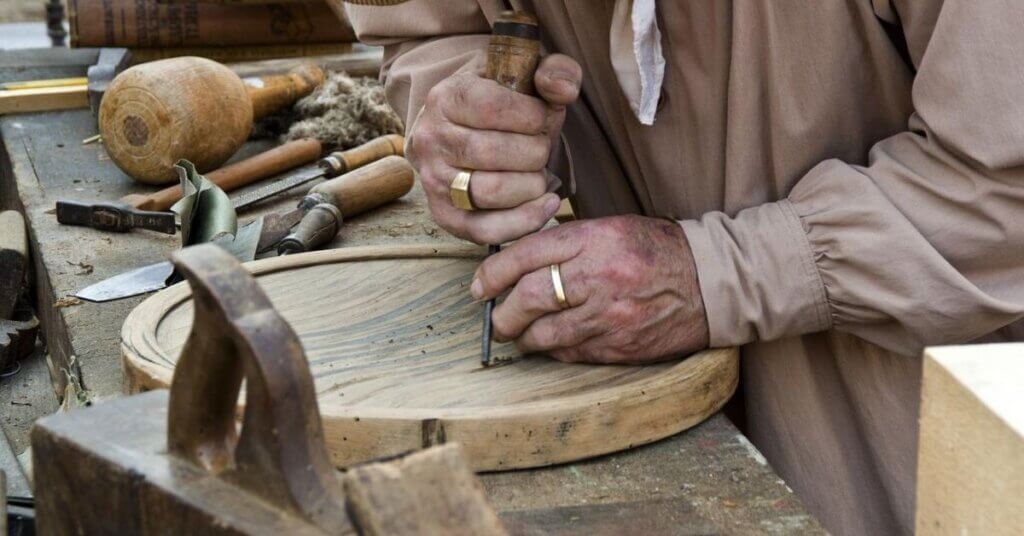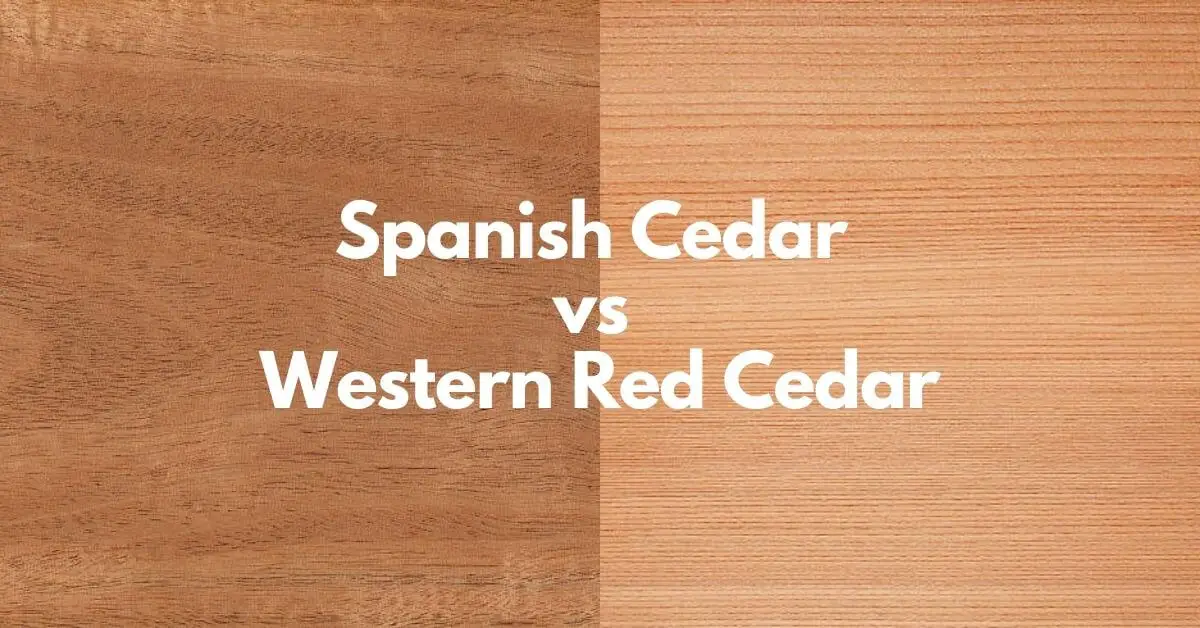Cedar is a wonderful wood species. It is a durable and strong softwood. Cedar doesn’t shrink, swell, warp. Therefore it is an excellent choice for exterior siding.
Spanish cedar is harder than western red cedar. Western red cedar has straight grain while Spanish cedar may also have interlocked grain.
Spanish Cedar (Cedrela odorata)
Spanish cedar is straight to interlocked grained wood. It is durable, stable, and rot-resistant softwood. Spanish Cedar is heavier and denser, with an excellent appearance.
Being rot-resistant and insect resistant, it is considered suitable for outdoor and interior applications.
Spanish cedar is also known as Cuban cedar or Cedro in Spanish. It is native to Native to Central and South America and the Caribbean.
Western Red Cedar (Thuja plicata)
Western red cedar is also very durable, with rot and insect-resistant softwood. It is a versatile wood that is used for many purposes.
Western Red cedar is also known as Giant Arborvitae. It is native to Native to Pacific Northwest United States/Canada.
Western Red Cedar is a large evergreen coniferous tree that can grow up to 165-200 ft tall.
| # | Spanish Cedar | Western Red Cedar |
| Scientific name: | Cedrela odorata | Thuja plicata |
| Average Dried Weight: | 29 lbs/ft3 (470 kg/m3) | 23 lbs/ft3 (370 kg/m3) |
| Janka Hardness: | 600 lbf (2,670 N) | 350 lbf (1,560 N) |
| Crushing Strength: | 5,860 lbf/in2 (40.4 MPa) | 4,560 lbf/in2 (31.4 MPa) |
| Rot Resistant: | Rot and termite resistant | Resistance to rot and insect attack. |
| Workability: | Easy to Work | Easy to work with hand and machine tools |
| Wood Color: | Light pinkish to reddish-brown | Reddish to pinkish-brown |
| Uses: | Veneer, plywood, cabinetry, musical instruments, humidors, and boatbuilding. | Shingles, exterior siding and lumber, boatbuilding, boxes, crates, and musical instruments. |
Uses of Spanish Cedar and Western Red Cedar
Common Uses
Musical Instruments
Cedar is widely used for making classical guitars and is an excellent choice for steel-string acoustics as well.
Western red cedar is a light and medium-density softwood, which makes it useful in crafting musical instruments.
Boat Building
Spanish Cedar and Western Red Cedar is a light dimensionally stable wood. Both kinds of wood do not absorb water readily and are highly resistant to decay. We can also call them moderately water-resistant.
As cedar is softwood, exterior finishing is essential to enhance outdoor use durability. The stain or paint closes the open pores of the wood so that the wood does not absorb moisture.
Spanish Cedar Uses
Veneer/Plywood
Spanish Cedar is widely used for making veneer sheets or plywood. Due to its layered construction, Cedar plywood tends to be far stronger than traditional cedar timber.
Furniture
Spanish cedar is a great choice for interior furniture as well as exterior furniture. It is easy to work. It gives excellent results after finishing.
Cabinetry
Spanish cedar is moderately hard and strong. The reddish-brown color looks attractive, Grains look even more attractive after the stain.
Western Red Cedar
Boxes/Crates
Western red cedar is light in weight, but strong wood. Due to being light, it is very easy to transport. Its great strength holds the heavyweight well.
Shingles
Western red cedar is very durable and has rot and decay resistance. Which can constantly withstand external elements. So it can be a great option for making quality shingles.
Exterior Siding
Western red cedar has a straight grain pattern with a uniform texture, Which looks very attractive and finishes well.
Cedar longboards, planks, and panels are readily available for exterior siding.
Color/Appearance
Spanish Cedar Wood Color
The color of the heartwood of Spanish Cedar is light pinkish to reddish-brown while the sapwood is almost white. Wood colors tend to darken with age, This process is accelerated in sunlight.
Generally, the grain is straight but also interlocked with medium texture and natural luster.
Western Red Cedar Wood Color
The heartwood of Western Red Cedar is reddish to pinkish-brown in color while the color of sapwood is pale yellowish-white. Somewhere there are red/brown stripes.
Western red cedar wood has a straight grain with a coarse texture and medium natural luster.
Working with Spanish cedar and Western Red Cedar

Spanish Cedar and Western Red Cedar are easy to work with both hand and power tools. Because of its low density and softness.
Due to their straight grain, planning and cutting become easy. Glue and finish well.
Due to the softness, Spanish Cedar tends to leave fuzzy surfaces, So it requires very sharp cutters.
Spanish cedar may have interlocked grains, which can make it a bit difficult to work with small tools.
How to Stain Cedar Spanish Cedar and Western Red Cedar
Staining is an essential process for protecting the natural color and preventing it from fading in the sun.
Almost all species of cedar are easy to stain, but some steps have to follow.
Step: 1 Sand the cedar board
Start with light sanding, the sanding process removes small dents and scratches. Also open the pores, So that the stain can go deep and remain for a long time.
If you are using a power sander, use an orbital sander with 100-grit sandpaper. Keep moving the sander continuously, do not keep it in one place.
Step: 2 Clean the boards
Now, You should clean the boards thoroughly before moving on to the next process. A lot of dust accumulates after sanding. Wet cotton cloth can be used for cleaning.
Step: 3 Apply Pre-Stain Wood Conditioner
To get a better uniform result, apply Pre-Stain Wood Conditioner. By applying it, the stain accepts uniformly and there is no problem with uneven and blotchy stains. Which is often a problem for softwood.
Step: 2 Apply Stain
Finally, you can apply stain, and apply two coats of stain. Keep a gap of 6 to 8 hours between the first and last coats.
Apply stain in the direction of the wood grain. So that the stain can penetrate deeply.
Do the whole process in a dust-free place and allow the wood to dry thoroughly after the final coating.
Spanish Cedar vs Western Red Cedar: Which is better for outdoor use?
Both woods are durable to moderately durable regarding decay resistance. They can be used for outdoor purposes.
Western red cedar is one of the most acceptable wood species for exterior use because of its hardness and stability. After finishing, it is ready to use outdoors.
Spanish Cedar and Western Red Cedar woods are also moderately water-resistant. Which does not absorb moisture easily and remains durable in the external environment.
Are Spanish Cedar and Western Red Cedar wood toxic?
Allergic reactions have been reported in cedar species. But Not all species have the same reaction.
Spanish Cedar Wood has been reported as a respiratory irritant. Whereas western red cedar has been reported as a sensitizer.
Be careful when working with wood dust, cover exposed parts of your body, and wear safety glasses. Asthma patients should avoid wood dust.

